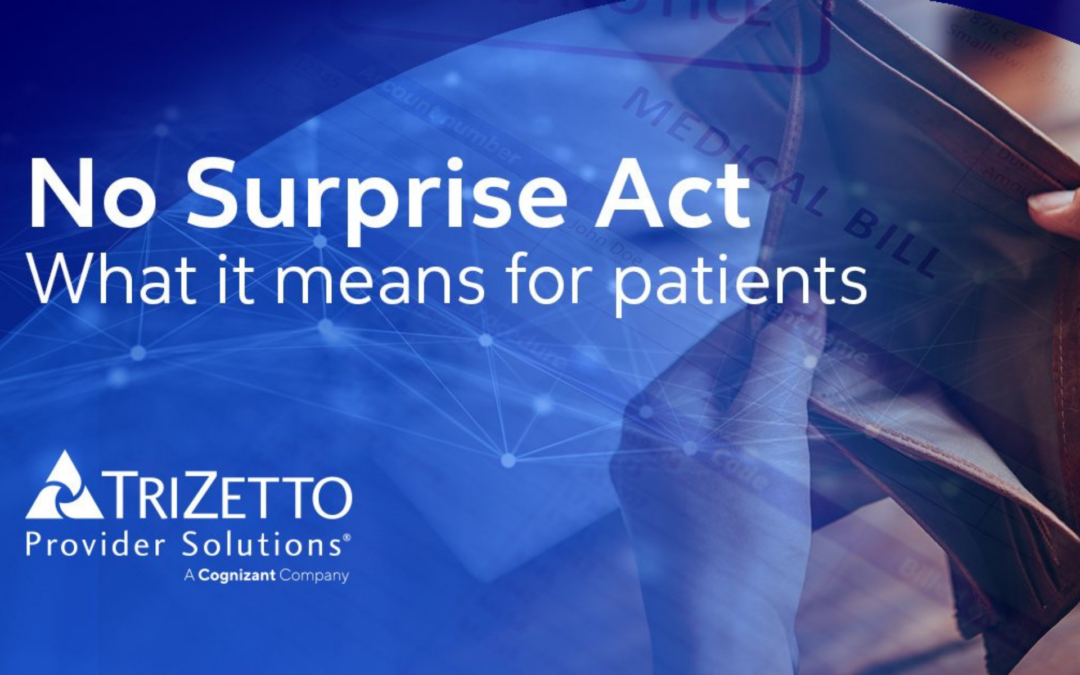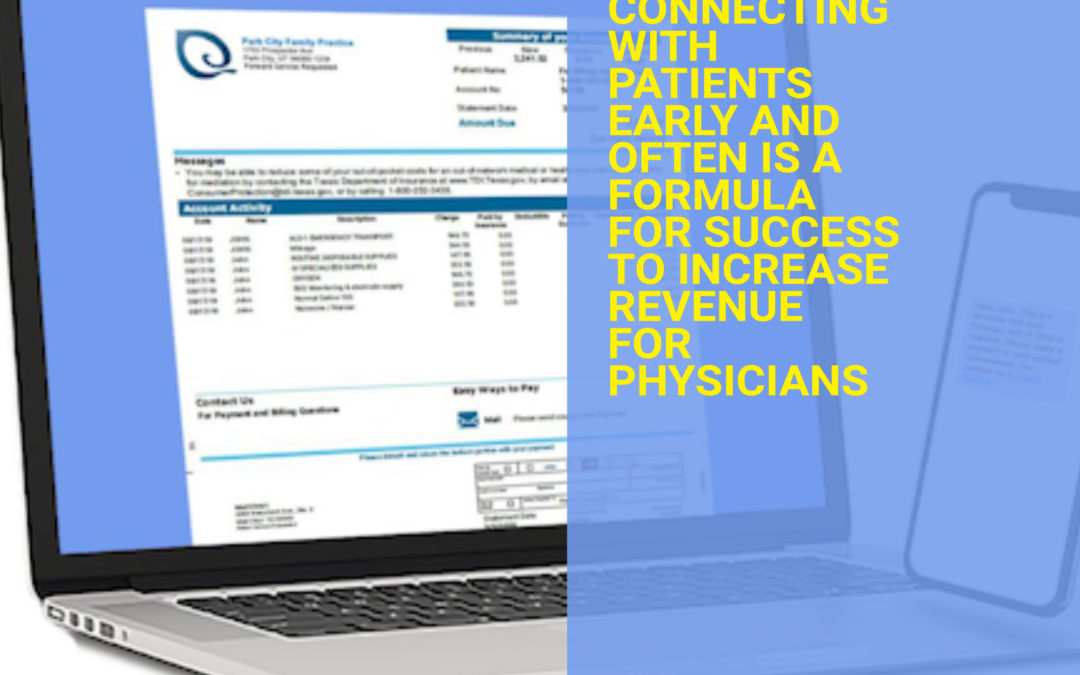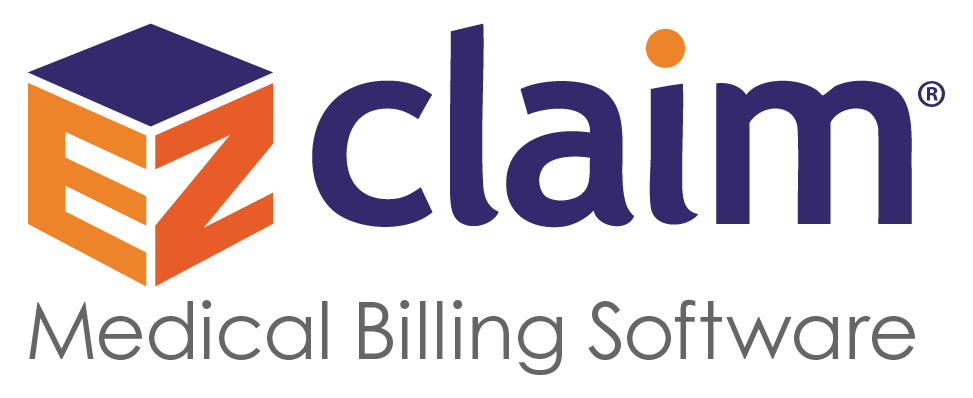
Oct 14, 2021 | Partner, TriZetto Provider Solutions
New No Surprise Act Tackles Unexpected Medical Bills
Two-thirds of bankruptcies filed in the United States are a result of medical expenses. It’s an alarming statistic, but probably not surprising. It’s no secret that many people have trouble paying out-of-pocket medical costs, so much so that a recent survey from The Commonwealth Fund found that 72 million Americans have some sort of trouble with medical debt.
It’s a common problem, but why? Let’s say a person visits a hospital, perhaps an emergency room, and receives a myriad of services. Maybe they arrived via ambulance or required treatment from an anesthesiologist. Although they may inquire about an estimate at the time of service or have an idea of their coverage, the exact financial responsibility is often a mystery. But what’s a person to do? They need medical assistance, and they need it at that moment. Then a surprise arrives in the mail in the form of an outrageously high medical bill. It’s something many of us have likely experienced.
What’s the cause of such an expense? Often the charge stems from using an out-of-network provider. Basically, this means that the hospital may have been in-network, but the physicians were not. Additionally, patients are often confused about medical coverage. Even with a good understanding of their benefits, situations may arise that are out of their control, and there may be unintended outcomes. Patients may (falsely) believe that all services rendered will be considered in-network when they go to an in-network facility. However, this isn’t always the case. In some instances, even though their physician is in-network, patients referred to specialists (such as a pathologist or radiologist) may discover the ancillary services were out of network. It is only after the patient receives a bill that they discover the issue. In the case of an emergency visit, patients don’t have the luxury of researching for in-network hospitals and typically go to the nearest hospitals. Patients may also be taken to out-of-network hospitals by ambulance. Researchers estimate that 1 in 6 emergency room visits and inpatient stays involve care from at least one out-of-network provider. The cost of out-of-network visits can have devastating financial consequences for the patient.
A 2019 study by the Government Accountability Office (GAO) found that the cost for air ambulance services clocked in at approximately $40,000. A large portion of this cost (over 70 percent) often fell out-of-network, meaning that the balance usually was placed on the consumer. When such a service is needed, it’s understandable to not have the option to “shop around” for a cheaper, in-network alternative.
Thankfully, help is on the way. Leaders and policymakers at the federal level have taken steps to tackle the issue. On July 1, 2021, the Biden Administration announced a new rule aimed at protecting consumers from surprise medical bills. In conjunction with the Department of Health and Human Services (HHS), together with the Departments of Labor and Treasury and the Office of Personnel Management, debuted “Requirements Related to Surprise Billing; Part I.”
This announcement, the first in a series, will go into effect on January 1, 2022, and protect patients from those all-too-common surprise medical bills. It’s an important step forward in protecting patients.
“No patient should forgo care for fear of surprise billing,” stated HHS Secretary Xavier Becerra. “With this rule, Americans will get the assurance of no surprises.”
Let’s dive into the new regulation. Among other provisions, the rule:
-
- Protects patients from surprise billing in emergency services. These provisions will safeguard patients in emergency care situations from unknowingly accepting out-of-network care and incurring unexpected expenses.
- Limits out-of-network cost-sharing. Patient cost-sharing for emergency and non-emergency services, such as a deductible, cannot be higher than if provided by an in-network provider. Simply put, co-insurance or deductibles must be based on in-network rates.
- Bans out-of-network charges for ancillary care. Previously, out-of-network providers like anesthesiologists could have been assigned, even though the facility or physician was in-network.
- Requires that providers and facilities provide patients with accurate cost information and advance notice of any out-of-network charges for non-emergency services. A consumer notice must explain that patient consent is required to receive care on an out-of-network basis before that provider can bill at the higher out-of-network rate.
- Allows providers and insurers access to a dispute resolution process should reimbursement issues arise around reimbursement.
With the increase in high deductible health plans and increased out-of-pocket costs, finances are top of mind. From the consumer’s standpoint, gaining healthcare services will be less stressful. On the simplest level, this ruling will hopefully eliminate those hefty surprise bills, which can only be seen as a positive. Moving forward, patients can rest assured that they will be more aware of expenses and will avoid out-of-network charges for emergency care.
So can consumers finally say goodbye to surprise medical bills? Hopefully, they become a thing of the past. And how will this bill affect the future of the industry? Advocates are hoping these regulations and newfound transparency will eventually lower costs, for one. More importantly, it shines a light on the need to improve the overall patient experience. It’s a step in the right direction and has the potential to improve healthcare policies going forward for years to come.
For more information on solutions that equip you to have informed conversations about financial responsibility and eligibility, contact a TriZetto Provider Solutions representative today.
ABOUT EZCLAIM:
As a medical billing expert, EZClaim can help the medical practice improve its revenues since it is a medical billing and scheduling software company. EZClaim provides a best-in-class product, with correspondingly exceptional service and support. Combined, EZClaim helps improve medical billing revenues. To learn more, visit EZClaim’s website, email them, or call them today at 877.650.0904.

Aug 31, 2021 | Support and Training
As a medical billing software company, EZClaim has worked and built relationships with thousands of billing experts across the country. With the aim of helping establish a standard of best practices, we have come up with 3 keys to being a medical billing expert. If you own a medical billing company or are studying to be a medical biller, then you will not want to miss these.
1. Strong Communication Skills
Medical billers must interact with a variety of individuals in their roles.
One of the most important people a medical biller must learn to communicate with is the patient. It is a biller’s job to be courteous, transparent, and offer up solutions to problems. Clearly communicating to patients their financial responsibilities will allow for the medical biller to complete the claim. It is also crucial for a medical biller to communicate well with their provider. If a patient’s claim is not complete, the biller must feel comfortable reaching out to the health care provider to find the missing pieces. Proper classification and correct billing methods is a critical component to getting paid.
2. Be Proactive
Be proactive in furthering your knowledge, the medical billing industry is continuously changing, and it benefits a biller to remain on top of the industry standards. There are billing associations you can join such as the American Medical Billers Association. Taking classes at a local community college or attending a billing school will help hone your skills. If a medical biller has gone through certification, these should be kept current.
3. Strong Follow-Up Skills
A good medical biller understands that having a strong follow-up and watching their dates is a critical component of revenue collecting. Identifying and correcting time management issues will increase productivity. An effective medical biller will set follow-up dates to track claims and set reminders in their billing program.
EZClaim offers many tools to assist billers with follow-up tasks. Between customized grids, follow-up reports, tasks, and reminders there’s a tool that will work for you and your workflow process.
In conclusion, a thorough knowledge of billing software, processes, and practices, is just one component to becoming an effective biller. Building strong relationships with patients, providers, and insurance companies through excellent communications and strong follow-up skills will ensure that patients stay satisfied with the medical practice and that providers are paid in a timely manner.
ABOUT EZCLAIM:
As a medical billing expert, EZClaim can help the medical practice improve its revenues since it is a medical billing and scheduling software company. EZClaim provides a best-in-class product, with correspondingly exceptional service and support. Combined, EZClaim helps improve medical billing revenues. To learn more, visit EZClaim’s website, email them, or call them today at 877.650.0904.

Jul 14, 2021 | BillFlash, Partner
There is no surprise that the cost of healthcare continues to rise creating financial hardships not only for patients but for physicians as well. While the COVID-19 pandemic severely impacted how patients interacted with their physician’s office, it is important to understand that patients want to be financially responsible for their medical bills and have preferences on communication methods to increase revenue.
In order to improve the overall patient experience and collection of revenue, it is important for physician offices to truly understand the demographics of their patients and the differences amongst their generational behaviors. Using a one-size-fits-all approach to communicate with patients is an outdated method and oftentimes leads to patient frustration, lack of engagement, poor retention, and missed opportunities to enhance revenue collection.
In a recent article published last month, physicians must adapt to the patient’s digital experience in order to enhance receiving payments for medical bills (Healthleaders, 2021). Patients desire modern payment options such as a payment portal, mobile ability, texting capabilities, and/or scanning a QR code. In addition, 76% of healthcare consumers desired a contactless method that allowed them to view their statements online and make payments without the need to visit the doctor’s office. According to (Healthleaders, 2021), the number one payment option patients desire is contactless debit and credit card options. In addition, patients desire payment options to help them manage their medical expenses such as payment plans and/or auto-pay methods.
As a medical billing expert, EZClaim can help medical practices improve their revenue through their billing and scheduling software in conjunction with BillFlash, which provides contactless and modernized communication methods that patients highly desire. Let EZClaim and BillFlash enhance the options to modernize your medical billing and communication systems.
ABOUT EZCLAIM:
As a medical billing expert, EZClaim can help the medical practice improve its revenues since it is a medical billing and scheduling software company. EZClaim provides a best-in-class product, with correspondingly exceptional service and support. Combined, EZClaim helps improve medical billing revenues. To learn more, visit EZClaim’s website, email them, or call them today at 877.650.0904.

Mar 10, 2021 | Credit Card Processing, Medical Billing Customer Service, Medical Billing Software Blog, Trizetto Partner Solutions
What is Price Transparency?
It’s a story we hear too often. A person visits a hospital for a medical issue—whether it be a trip to the emergency room for a broken arm or a pre-scheduled appointment for a headache that just won’t go away—and receives a myriad of services and tests. Then comes the dreaded bill in the mail a few weeks later. Although they may inquire about an estimate at the time of service or have an idea of their coverage, the exact financial responsibility is often a mystery until that bill arrives. While the changes vary greatly, one thing that is certain: many people have trouble with their out-of-pocket costs. So much so that a recent survey from The Commonwealth Fund found that 72 million Americans have some sort of trouble with medical debt.
So, on January 1, 2021, the price transparency rule was put into effect—from the Centers for Medicare and Medicaid Services (CMS)—requiring all hospitals within the United States hospitals to publish the prices of various medical procedures. In particular, standard charges for services and items must be published online, available for patients to access. Until now, these prices were hard to find. The timing of this change—the beginning of the calendar year—comes at a time when healthcare pricing is top of mind since many customers most likely renewed or changed insurance carriers and coverage on January 1, 2021. With this comes a focus on out-of-pocket costs, deductibles, and more.
What Brought About This Radical Change?
Part of this change can be attributed to the consumers themselves. With the increase in high deductible health plans and increased out-of-pocket costs, finances are top of mind. In addition to these factors, today’s consumers demand a better overall patient experience. With the prevalence of online shopping, patients expect the same seamless transaction at the hospital that they receive with companies like Amazon, Walmart, and Home Depot. Just as consumers read product reviews before placing an item in their online shopping cart, patients research services and access peer reviews of physicians before they go to the office. In short, they want to be knowledgeable about their healthcare and crave tailored services with exceptional customer service.
Many believe this change will be well received, with Forbes calling the ruling a “gift to all Americans.” From the consumer’s standpoint, it will now be easier to make educated decisions based on cost. This will then cut down on the “unknown”—hopefully eliminating those hefty surprise bills—and opens the door to comparison shopping. Advocates are hoping this newfound transparency will eventually lower costs, with the competition eventually driving down the prices.
How Can Healthcare Organizations Navigate This Change?
This will not only promote transparency but will also increase convenience. By enabling patients to access and pay their bills on their own schedule with easy-to-implement solutions, organizations are meeting them halfway, so to speak. With easy-to-understand statements, integrated credit card processing, and 24/7 payment portals, it is no longer a hassle to manage medical financials. For healthcare organizations, facilitating proactive management of a person’s cost of care accelerates revenue collections and patient satisfaction improves.
In the larger sense, executives recognize that patients are taking more stock in their personal care. In order to thrive, hospitals and health systems must work toward creating the optimal patient experience, beyond just price transparency. With this, providers should aim to be more engaged and C-suite executives should try to provide additional benefits to their patients.
What Will This Mean for the Future of the Industry?
Only time will tell what the price transparency will mean for the industry. However, it is safe to say that this concept has the possibility to shape healthcare policies and processes for years to come.
So, for more information on solutions that equip you to have informed conversations about eligibility and financial responsibility, contact one of EZClaim’s partners, TriZetto Provider Solutions, to talk with one of their representatives today.
ABOUT EZCLAIM:
EZClaim is a medical billing and scheduling software company that provides a best-in-class product, with correspondingly exceptional service and support. Combined, they help improve medical billing revenues. To learn more, visit EZClaim’s website, e-mail them, or call them today at 877.650.0904.
[ Article contributed by TriZetto Provider Solutions Editorial Team ]





